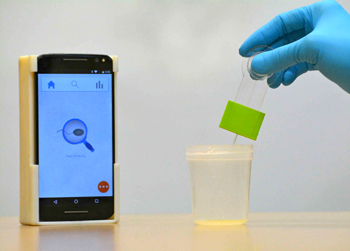Boston, Mar 23: Scientists have developed a new smartphone-based device to measure semen quality, an advance that may prove to be a boon in countries lacking access to fertility tests.
 Researchers, including those from Massachusetts General Hospital (MGH) in the US, have built an analyser consisting of an optical attachment that can connect to a smartphone and a disposable device onto which a semen sample can be loaded.
Researchers, including those from Massachusetts General Hospital (MGH) in the US, have built an analyser consisting of an optical attachment that can connect to a smartphone and a disposable device onto which a semen sample can be loaded.
The new test utilises the advancements in consumer electronics and microfabrication. A disposable microchip with a capillary tip and a rubber bulb is used for simple, power-free semen sample handling.
Scientists also designed a user-friendly smartphone application that guides the user through each step of testing, and a miniaturised weight scale that wirelessly connects to smartphones to measure total sperm count.
Researchers collected and studied about 350 clinical semen specimens at the MGH Fertility Centre to evaluate the test.
Overall, the smart phone-based device was able to detect abnormal semen samples based on World Health Organisation (WHO) thresholds for sperm concentration and motility with an accuracy of 98 per cent.
The team also evaluated how well both trained and untrained users performed the test using the smartphone-based device.
"We wanted to come up with a solution to make male infertility testing as simple and affordable as home pregnancy tests," said Hadi Shafiee of Brigham and Women's Hospital in the US.
"Current clinical tests are lab-based, time-consuming, and subjective. This test is low-cost, quantitative, highly accurate, and can analyse a video of an undiluted, unwashed semen sample in less than five seconds," Shafiee added.
The study was published in the journal Science Translational Medicine.





Comments
Add new comment